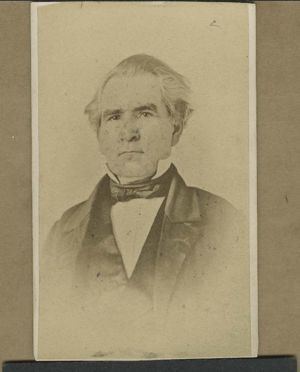Name Johnston Lykins | ||
 | ||
Died August 15, 1876, Kansas City, Missouri, United States | ||
Johnston Lykins (April 15, 1800 – August 15, 1876) was a prominent figure in the early history of the United States frontier settlement which became Kansas City, Missouri. He was the city's second Mayor.
Contents

Biography
Lykins was born in Franklin County, Virginia. He became involved with the work being performed among the area's American Indian tribes by Isaac McCoy, joining the McCoy mission to the Wea peoples in northern Indiana in 1819. Lykins was hired as a schoolteacher, not a missionary (he had not been baptized into the fold at that time), and he spent more time traveling for supplies and assisting the mission's functions than he did teaching school. He quit several times over the first several years, but kept returning.
In 1820 McCoy moved his mission to Fort Wayne, Indiana, and in 1822 moved again to Michigan Territory, founding the Carey Mission among the Potawatomi people. Lykins was baptized in 1822 and was soon appointed as a missionary by the Baptist Board of Missions for the United States.
Lykins applied himself diligently to his calling, and by 1824 could read religious discourses in the Potawatomi language. He continued in Michigan until 1831, and in 1828 he married Delilah McCoy, Isaac's daughter.
The Indian Removal Act of 1831, which Lykins and McCoy had been essentially advocates of, resulted in many of the mission's constituents moving westward, and in 1831 Lykins went with them, founding a mission in Missouri near the Shawnee reservation. This first move was a prelude to the later 1838 removals, known as the Potawatomi Trail of Death.
The Baptist mission board approved funds for printing religious tracts in native-American languages, so in 1833 Jotham Meeker brought the first printing press to the Shawnee Mission. Books in Shawnee, Potawatomi and other native languages were rapidly produced, to be used in missionary educational programs. Lykins was actively involved and edited the Sinwiowe Kesibwi (Shawnee Sun), a small newspaper published entirely in Shawnee.
In 1843 Lykins founded a mission among the Potawatomi near Topeka, Kansas. In that same year, some of the tribal elders requested that he be named their tribal physician, a government post that provided him with a salary that was necessary to support the mission. His appointment was opposed by the Jesuits and the Potawatomi allied with them, but was granted in 1844. However, in that area quarrels abounded between clergy of the different Christian religions and even clerics of the same faith. Lykins was an enthusiastic participant in these, and made many enemies. This, compounded by their criticism of his lack of medical credentials, led to his dismissal from the government post (Physician to the Potawatomi) in 1851.
In 1848 Lykins began a trade school at the mission, and after three years he had 90 students.
Lykins left the Potawatomi mission soon after losing his medical position, returning to the Shawnee mission until 1855, when it was closed. At that time he moved to Kansas City, to be near his son.
Kansas City activity
In 1831 Lykins purchased 16 acres (6.5 ha) in what would become the initial plat for Kansas City (his property extended south from the Missouri River to Fifth and Broadway). He later expanded his holdings to 12th and Pennsylvania on Quality Hill.
While residing in Kansas City, Lykins functioned as a medical doctor, apparently self-taught. He was also named president of Mechanics Bank.
He married again in 1851. His second wife was Martha A. Livingston, who wrote a manuscript entitled "Recollections of Early Times in Kansas City" which is now in the collection of the Jackson County Historical Society.
Kansas City after being incorporated in 1853 first elected William Samuel Gregory. Gregory served only 10 months when it was discovered that he was not eligible to be mayor because he did not live within the city limits. Lykins who was first president of the city council became mayor. After completing two months of Gregory's term he was elected to another one-year term.
During the American Civil War he maintained loyal Union ties while his new wife had to move to Clay County, Missouri as a result of General Order No. 11 which required loyalty oaths for those living near the Kansas border south of the Missouri River.
Lykins continued to reside in Kansas City until his death in 1876. He is buried in Union Cemetery, Kansas City, Missouri.
